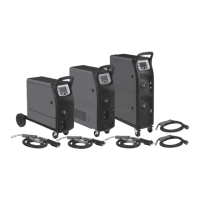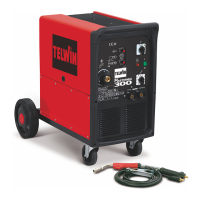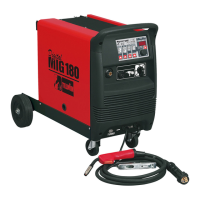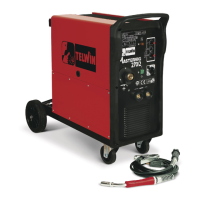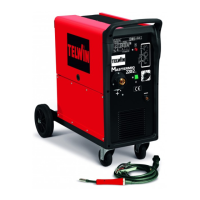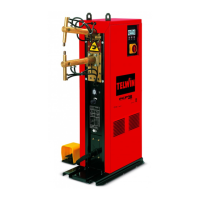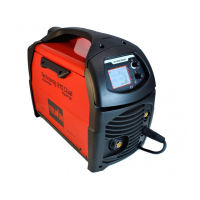1.GENERAL SAFETY RULES FOR5. INSTALLATION.........................................................6
5.1 PRELIMINARY OPERATIONS..................................................................6
RESISTANCE WELDING...........................................5
5.2 LIFTING THE SPOT-WELDER..................................................................6
5.3 POSITION .................................................................................................6
5.4 CONNECTION TO THE MAIN POWER SUPPLY......................................6
2. INTRODUCTION AND GENERAL DESCRIPTION.....6
5.4.1 Warnings...........................................................................................6
2.1 INTRODUCTION......................................................................................6
5.4.2 Plug and socket................................................................................6
2.2 STANDARD ACCESSORIES...................................................................6
2.3 OPTIONAL ACCESSORIES.....................................................................6
6. (SPOT) WELDING ......................................................6
6.1 PRELIMINARY OPERATIONS..................................................................6
3. TECHNICAL DATA......................................................6
6.2 ADJUSTING THE (spot-welding) PARAMETERS ....................................6
3.1 RATING PLATE ........................................................................................6
6.2.1. Digital Models .................................................................................6
3.2 OTHER TECHNICAL DATA .......................................................................6
6.2.2. Model TI..........................................................................................6
6.3 PROCEDURE............................................................................................6
4. DESCRIPTION OF THE SPOT-WELDER....................6
4.1 PRINCIPAL COMPONENTS AND ADJUSTMENTS ...............................6
7. MAINTENANCE.........................................................7
4.2 CONTROL PANEL (only for DIGITAL models)........................................6
7.1 ROUTINE MAINTENANCE......................................................................7
7.2 EXTRAORDINARY MAINTENANCE........................................................7
INDEX
ENGLISH
pagepage
-METAL PROSTHESES
-Data transmission or local telephone networks
-Instrumentation
-Clocks and watches
-Magnetised cards
WEARERS OF VITAL ELECTRICAL OR ELECTRONIC DEVICES AND PEOPLE
APPLIANCES FOR RESISTANCE WELDING FOR INDUSTRIAL AND
WITH METAL PROSTHESES SHOULD NOT BE ALLOWED TO USE THE SPOT-
PROFESSIONAL USE
WELDER.
Note: In the following text the term spot-welder will be used.
SUCH PERSONS SHOULD TAKE MEDICAL ADVICE BEFORE STOPPING IN
THE VICINITY OF SPOT-WELDERS AND/OR WELDING CABLES.
1.GENERAL SAFETY RULES FOR RESISTANCE
WELDING
The operator should be properly trained to use the spot-welder safely and should
-This spot-welder complies with all requirements of the technical standard for
be informed of the risks connected with resistance welding procedures, of
the product, which to be used only and exclusively in industrial environments
related protection measures and of emergency procedures.
and for professional purposes.
Electromagnetic compatibility with a domestic environment cannot be
guaranteed.
-Electrical installation should be carried out following accident-prevention
RESIDUAL RISKS
legislation and standards.
-The spot-welder should be connected only and exclusively to a power supply
- RISK OF UPPER LIMBS BEING CRUSHED
with the neutral conductor connected to earth.
Both the operating method for the spot-welder and the variability in shape and
-Make sure the power supply outlet is correctly connected to the earth
size of the piece being welded make it impossible to provide integrated
protection.
protection against the danger of the upper limbs being crushed: fingers,
-Do not use cables with worn or damaged insulation or with loosened
hands, forearm.
connections.
The risk should be reduced by appropriate preventive measures:
-Do not use the spot-welder in damp or wet environments or in the rain.
-The operator should either be expert or trained in resistance welding
-When connecting the welding cables or carrying out any routine maintenance
procedures using this type of appliance.
operation on the arms and/or electrodes the spot-welder should be switched
-There should be risk evaluation for every type of job to be done; equipment
off and disconnected from the power supply.
and masking should be provided to support and guide the work-piece
The same procedure should be followed when making connections to the
(unless a portable spot-welder is used).
water supply or to a closed circuit cooling unit (water-cooled spot-welders)
-Whenever the shape of the piece allows it, adjust the electrode distance so
and whenever repairs are made (extraordinary maintenance).
that the stroke does not exceed 6 mm.
-Do not allow more than one person to work on the same spot-welder at the
same time.
-Unauthorised persons should not be allowed in the working area.
-Do not leave the spot-welder unattended: in such a case it should be
disconnected from the power supply.
-Do not weld on containers, receptacles or piping that contain or have
contained flammable liquid or gas products.
-RISK OF BURNS
-Do not operate on materials cleaned with cholorinated solvents or near such
Some parts of the spot-welder (electrodes arms and nearby areas) may reach
substances.
temperatures of over 65°C: suitable protective clothing must be worn.
-Do not weld on pressurised containers.
-RISK OF TIPPING AND FALLING
-Remove all flammable substances from the work area (e.g. wood, paper, rags
-Place the spot-welder on a level horizontal surface that is able to support its
etc.).
weight; confine the spot-welder to the support surface (when required in the
-Make sure there is sufficient ventilation or provide means for removing
INSTALLATION section of this manual). Otherwise with inclined or uneven
welding fumes near the electrodes; a systematic approach is necessary to
floors or moveable supporting surfaces there is the danger of tipping.
evaluate limits of exposure to the welding fumes depending on their
-Never lift the spot-welder unless explicitly required by the INSTALLATION
composition and concentration and on the length of exposure.
section of this handbook.
-IMPROPER USE
It is dangerous to use the spot-welder for any other purpose than that for
which it is designed (spot resistance welding).
,
*
)
-Always protect the eyes with suitable eye protectors.
- Wear protective gloves and clothing suitable for resistance welding work.
- Noise levels: If the personal daily exposure level (LEPd) is found to be greater
PROTECTIONS
than 85db(A) due to particularly intensive welding operations, wearing
personal protection devices is compulsory.
The safeguards and moveable parts of the spot-welder casing should all be in
position before connection to the power supply.
WARNING: All manual operations on moveable accessible parts of the spot
welder, for example:
-Electrode replacement or maintenance
#$%
(&
-Adjusting the position of the arms or electrodes
- The strong magnetic fields generated by resistance welding processes (very
SHOULD BE CARRIED OUT WITH THE SPOT-WELDER SWITCHED OFF AND
high currents) may damage or interfere with:
DISCONNECTED FROM THE POWER SUPPLY.
-CARDIAC STIMULATORS (PACE MAKERS)
-ELECTRONICALLY CONTROLLED IMPLANTED DEVICES
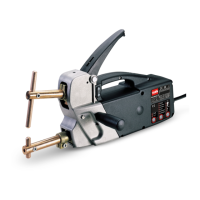
